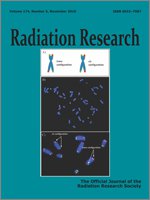This study reports the effects of denaturation and deoxygenation on radiation-induced formation of 2-deoxyribonolactone (2-dL) and 5′-aldehyde (5′-Ald) lesions in highly polymerized DNA. The radiation-chemical yields of 2-dL were determined through quantification of its dephosphorylation product 5-methylenefuranone (5MF). The formation of 5′-Ald was monitored qualitatively through the release of furfural (Fur) under the same conditions. The yields of 2-dL were found to be 7.3 ± 0.3 nmol J−1, or about 18% of the yield of free base release measured in the same samples. Denaturation increased the efficiency of 2-dL formation approximately twofold while deoxygenation resulted in a fourfold decrease. The release of Fur is about twofold lower than that of 5MF in aerated native DNA samples and is further reduced by denaturation of the DNA. Unlike 5MF, the formation of Fur requires the presence of molecular oxygen, which is consistent with peroxyl radical-mediated oxidation of C5′ radicals into 5′-Ald. In contrast, the existence of an oxygen-independent pathway of 2-dL formation suggests that C1′ sugar radicals can also be oxidized by radiation-produced oxidizing intermediates such as electron-loss centers on guanines.
How to translate text using browser tools
7 September 2010
Factors Affecting the Yields of C1′ and C5′ Oxidation Products in Radiation-Damaged DNA: The Indirect Effect
Charles S. Price,
Yuriy Razskazovskiy,
William A. Bernhard
ACCESS THE FULL ARTICLE

Radiation Research
Vol. 174 • No. 5
November 2010
Vol. 174 • No. 5
November 2010




